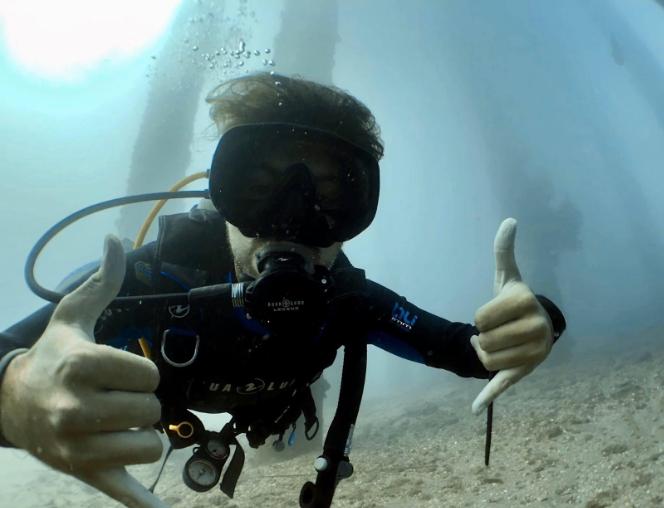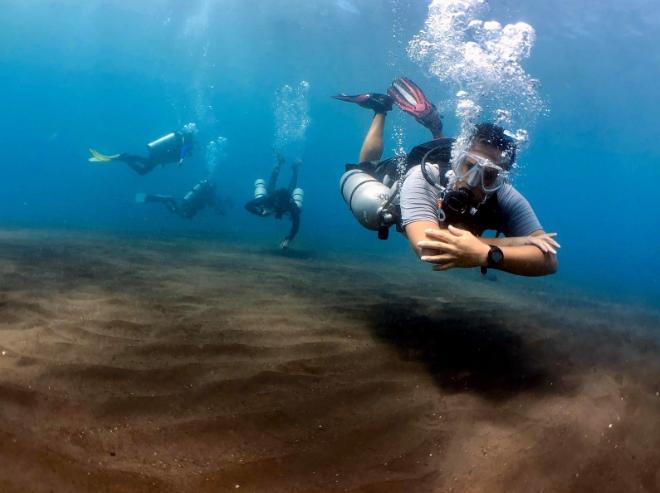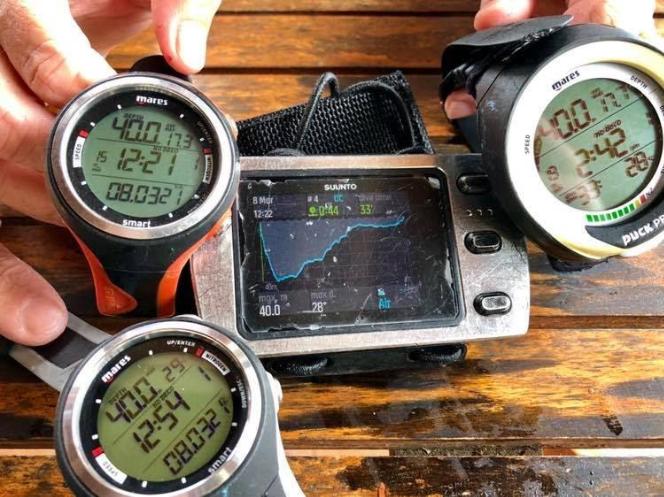Fun With Physics: Teaching Buoyancy Basics
What do you get if you mix a lime, a tomato and an egg? Answer: a buoyancy training aid.
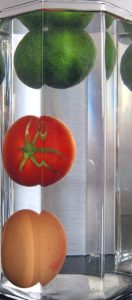 We learn about the importance of buoyancy as beginner divers in the very first module of our first course, because it is important for our enjoyment, safety and protection of the fragile aquatic environment. By the time we reach professional level training these skills are honed. It’s now time to help others with their buoyancy control and with their understanding of how buoyancy works.
We learn about the importance of buoyancy as beginner divers in the very first module of our first course, because it is important for our enjoyment, safety and protection of the fragile aquatic environment. By the time we reach professional level training these skills are honed. It’s now time to help others with their buoyancy control and with their understanding of how buoyancy works.
In the IDC and IE, PADI Instructor candidates will be tested on their theoretical understanding of buoyancy because they need to be able to teach it. It’s therefore important to make sure the foundation is solid. So let’s do a check up on Buoyancy Basics dive theory for Pros.
For introducing buoyancy to dive students we might get some objects in a tall jug of water: one negatively buoyant sitting on the bottom, one positively buoyant floating at the top, and ideally one neutral right in the middle as well!
Making an object neutral is no easy task though (at least without a BCD on it anyway), so in the making of this photo I made use of an important fact about buoyancy: not only does the object itself have an effect on buoyancy, but the liquid that the object is in will have an effect too. Divers know that weighting is a little different in salt water (the ocean) compared to fresh water (a pool or lake). More lead is needed in the ocean because we have more positive buoyancy in salt water compared to fresh water.
Why is that? If we take a liter of each type of water and put it on a weighing scale, we find out that:
- 1 liter of salt water weighs 1.03 kilograms
- 1 liter of fresh water weighs 1.00 kilogram
This information is written down at the beginning of all PADI dive theory exams that require buoyancy calculations. Because salt water weighs more per liter, the volume of water displaced by an object weighs more in salt water than in fresh water, thus giving the object more upward force. Salt water is better at buoying up an object (like a bed supporting it) compared to fresh water.
So to get my tomato neutral, I chose one that was a close to neutral as possible then adjusted the salt levels! But if I had chosen a different object – say a small lead weight – even adding lots of salt would not have had an impact: the object itself would be very negative to start with.
A common dive theory physics question asks what would happen to an object if it were moved from salt to fresh, or vice versa. Here’s a diagram to help us to look at these type of questions:
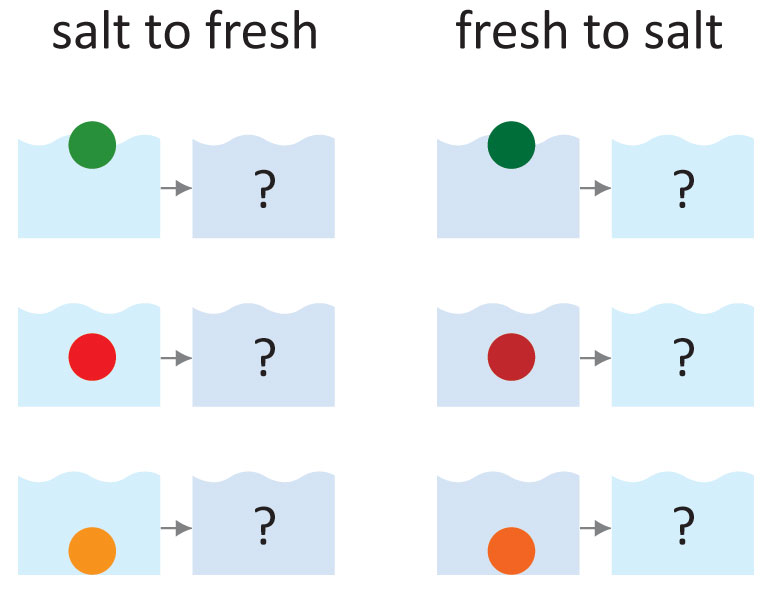
So on the left we have the situation where we move the object from salt to fresh, then on the right we’ll look at going the other way, from fresh to salt. We will consider 3 situations: we will first see what happens if the object starts neutral (balanced in the water column), secondly we will look at what happens if we start with the object positive (at the surface), and finally we will look at what happens if we start with the object negative (on the bottom).
Neutral buoyancy is a perfectly balanced state. Therefore, if anything changes at all, the balance will be gone and the buoyancy state will change.
 On the left is a neutral object in salt water. If we move it to fresh it will be less buoyant because there is no salt in the water to help buoy up the object. Since the perfect balance is gone, this object would now sink. Likewise, on the right we have a neutral object in fresh water. If we move it to salt water there is now salt in the water that helps buoy up the object and it will be more positive. Since the perfect balance is gone, the object would now float. So, those two are easy.
On the left is a neutral object in salt water. If we move it to fresh it will be less buoyant because there is no salt in the water to help buoy up the object. Since the perfect balance is gone, this object would now sink. Likewise, on the right we have a neutral object in fresh water. If we move it to salt water there is now salt in the water that helps buoy up the object and it will be more positive. Since the perfect balance is gone, the object would now float. So, those two are easy.
Let’s now look at starting positively buoyant.
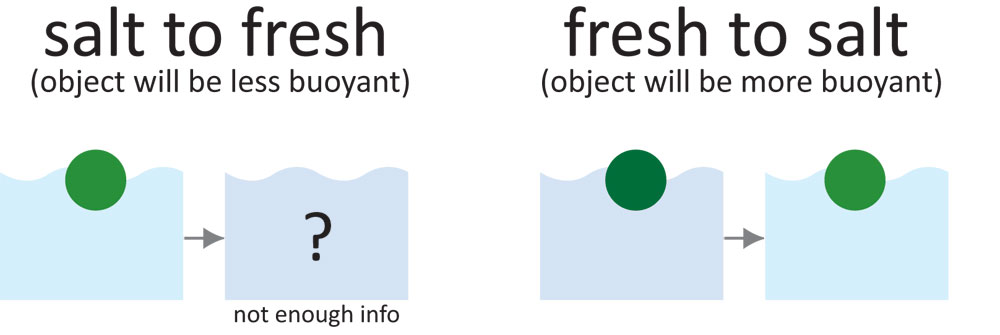 We’ll actually start with the easy one on the right side first: the object starts in fresh and gets put into salt water. Again, the salt buoys up the object and makes it more positive, so in this case we can be sure it continues to float. The left side is more tricky. In this case it starts in salt water and moves to fresh. It will lose some buoyancy with the water change, but will it be enough to make it become neutral or sink? Unless we have numerical facts about the object, we can’t know what happens. If for example it’s a surface marker it will probably still float because it started off very positive, whereas a different object (like a tomato!) might be a different story. We just don’t have enough information in this case.
We’ll actually start with the easy one on the right side first: the object starts in fresh and gets put into salt water. Again, the salt buoys up the object and makes it more positive, so in this case we can be sure it continues to float. The left side is more tricky. In this case it starts in salt water and moves to fresh. It will lose some buoyancy with the water change, but will it be enough to make it become neutral or sink? Unless we have numerical facts about the object, we can’t know what happens. If for example it’s a surface marker it will probably still float because it started off very positive, whereas a different object (like a tomato!) might be a different story. We just don’t have enough information in this case.
And now let’s take a look at starting negatively buoyant.
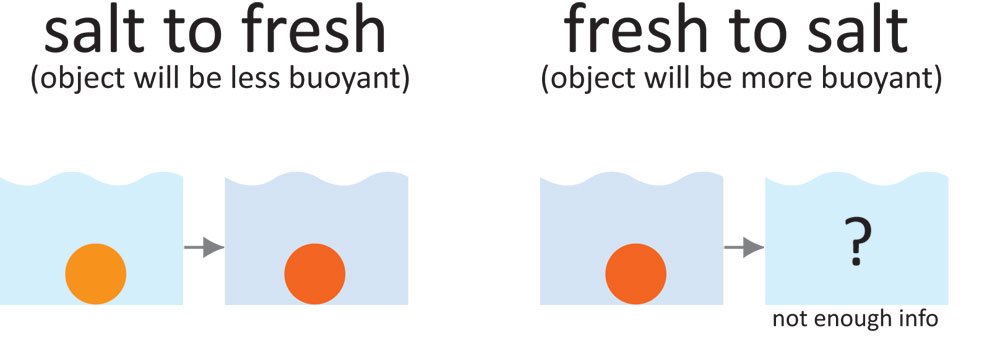 We’ll look at the left side first this time: that’s the easy one. The object starts in salt and gets put into fresh water. Without the salt, the object will be more negative, so in this case we can be sure it continues to stay at the bottom. The right side is more tricky. In this case it starts in fresh and moves to salt. It will gain some buoyancy with the water change, but will it be enough to make it become neutral or float? Unless we have numerical facts about the object, we can’t know what happens. If for example it’s an anchor it will probably still sink because it started off very negative, whereas a different object (like a tomato!) might be a different story. Again, not enough information.
We’ll look at the left side first this time: that’s the easy one. The object starts in salt and gets put into fresh water. Without the salt, the object will be more negative, so in this case we can be sure it continues to stay at the bottom. The right side is more tricky. In this case it starts in fresh and moves to salt. It will gain some buoyancy with the water change, but will it be enough to make it become neutral or float? Unless we have numerical facts about the object, we can’t know what happens. If for example it’s an anchor it will probably still sink because it started off very negative, whereas a different object (like a tomato!) might be a different story. Again, not enough information.
Can you see the pattern? For perfectly balanced neutral objects to start, we do have enough information if only the water type changes. For the others, where there is no perfect balance to start, the object’s characteristics play more of a role. And that’s why we need to be able to do calculations with buoyancy.
To find out more, look at these PADI resources:
- The Encyclopedia of Recreational Diving (pages 4-18 to 4-21)
- The Diving Knowledge Workbook (objective 1.5)
And look out for more blogs from our Pro team.
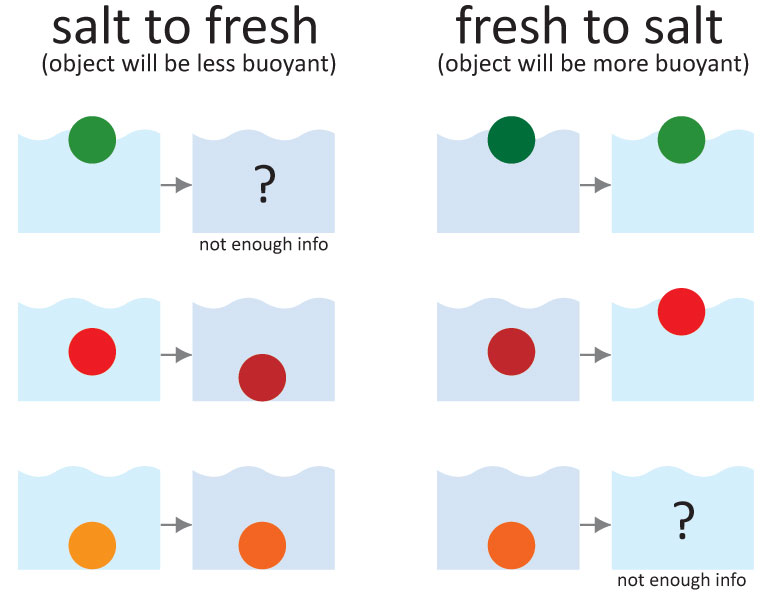
In the meantime, feel free to use this summary diagram – noting the pattern – to help with your studies. Enjoy.

